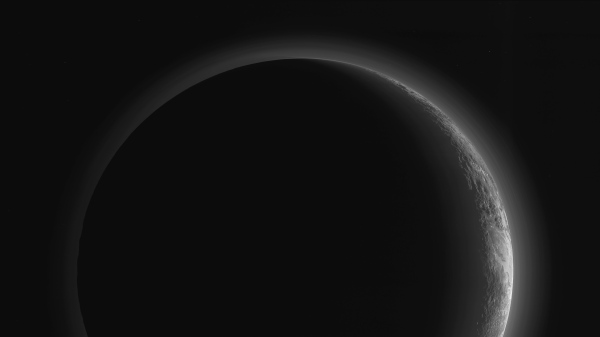
At the beginning of September the world was treated to a fantastic view of the night side of Pluto, captured by the New Horizons spacecraft as it departed the distant icy world on July 14, 2015. Backlit by the sun, Pluto’s surprisingly complex atmospheric haze created a ghostly glow above its crescent-lit limb while frozen mountains cast reflected light upon neighboring Plutonian peaks.
On Thursday, NASA released an update to that image showing a more complete view of Pluto in its backlit glory, created from more high-resolution images that continue to stream in from the Kuiper Belt-bound spacecraft, over three billion miles away.
I have a question, regarding the images and data being returned to us by various discovery missions, and I’m betting you are just the person to ask – especially considering your mention of how ‘surprisingly’ complex the atmospheric haze of Pluto is 🙂
While much of the data being reported back to us is revealing things we either had no idea about, or confirming things we thought we already had ideas about, how much of this data is challenging previously-held hypotheses? In other words, has any of the data from our various discovery missions in the Solar System demonstrated that our previous science was incorrect, or otherwise in need of improvement?
LikeLike
Of course. Models can only go so far, but will always be trumped by actual observations. Which then are used to revise the models. Real science exists in the shadowy darkness just outside what we know… that’s where we try to illuminate and turn our best guesses into knowledge. Sometimes what we thought was the case is in fact so, other times there are total surprises. If anything, complexity is the rule with new discoveries… missions like these help to increase the *resolution* of our awareness of the Universe.
LikeLiked by 1 person
You have a knack for the play on words! Thank you for answering my question … it is actually a comforting thought, that our science can still be – from time to time – proven wrong 🙂
LikeLike
Any working scientist is, over the course of his or her career, going to be wrong many more times than right. It’s just part of the process. But that’s what science is: an ongoing process. Observations and data are what really matters. If they happen to support one particular standing theory or hypothesis, great… if they do not, then science demands that the theory be revisited, the hypothesis re-hypothesized (and the observations re-made so as to rule out error.) It’s never fun to be wrong, but in science “wrong” can mean just as much for the big picture as “right”…often even more so.
LikeLiked by 1 person
Can’t they take a video of what’s happening on that planet…..
LikeLike
No. New Horizons does not have a video camera.
LikeLike